Everything you need to know to plan your trip to Japan
Atualizado em:
Thinking of planning a trip to Japan? So you’re in the right place, because in this post I’ve put together everything you need to know to start your planning and not make any mistakes when deciding things about your trip to Japan. We’ll give you tips such as when to go, how many days to stay, how to get around the country, and we’ll talk about some of the country’s peculiarities such as the JR Pass service, bag delivery, and portable wifi.
Understanding Japan: Geography
Japan is made up of 4 major and main islands: Hokkaido, Honshu, Shikoku, and Kyushu, as well as the thousands of southern islands that make up the Okinawa archipelago. Most tourists concentrate on Honshu, the largest of the islands and home to the best-known and most visited cities such as Tokyo, Kyoto, Osaka, and Hiroshima.
Japan is very close to Taiwan and Korea, and I almost couldn’t help myself including at least Taipei and Seoul in the travel itinerary. China is also right around the corner, but I believe that to contemplate both countries you’d need at least a month or 40 days of travel.

I tried to show to you guys the 4 major islands and the smaller Okinawa islands. I know the art is horrible, but you can get the picture, right? =)
Religion in Japan
Japan’s native and oldest religion is Shinto, or the path of the gods (Shin = god and to = path). From what we’ve seen, read and heard from our guides, Shinto considers sacred all the elements of nature, which are the Kami deities, which can be represented in hills, rocks, trees, and many other elements.
In the sixth century, Buddhism arrived in Japan (starting in India, passing through China and Korea until finally reaching Japan). The two religions coexisted in the past and still do to the present day, even though they have different characteristics. If you want to dig deeper into Japan’s religions, I recommend reading this quick article from Japan’s Embassy in Brazil.
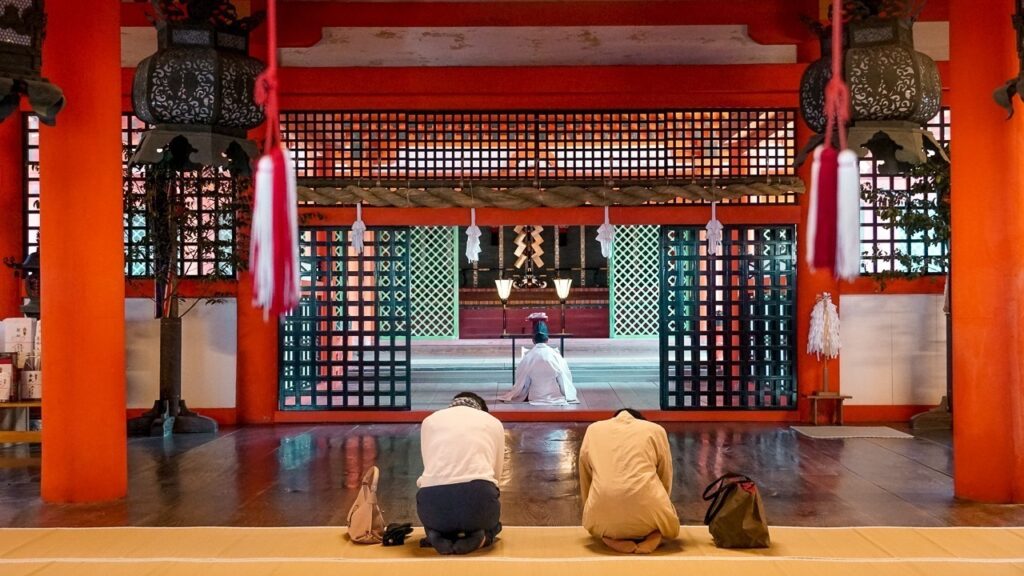
Itsukushima Sanctuary, in Miyajima.
It’s important to understand what these two religions are before going to Japan because most of the attractions are Buddhist temples or Shinto shrines. You know the floating Torii, in Miyajima? It’s a Shinto portal to the island that is considered sacred. And that beautiful golden pavilion temple in Kyoto? It’s a Buddhist temple.
When to travel to Japan? Climate and best months
The first step before taking time off work is to set the date of the trip, and this is a super important choice to make the most of your trip to Japan. The best time – and therefore the high season in Japan – is during the spring and cherry season. (March, April, and May) and the fall, with those beautiful reddish leaves (October and November).
The summer is very hot and rainy. From June the weather starts to get wearying with rain, and until September is still considered typhoon season. On the other hand, it’s only during the summer that it is possible to climb Mount Fuji and it’s a good time to visit Okinawa, the paradise islands of Japan.
Winter is very cold and looks completely different. Consider visiting the white landscapes of Hokkaido Island and skiing there, as well as enjoying the onsens (hot spring baths). If you’re one of those people who can’t stand the cold, get as far away as you can from Japan this time of year.
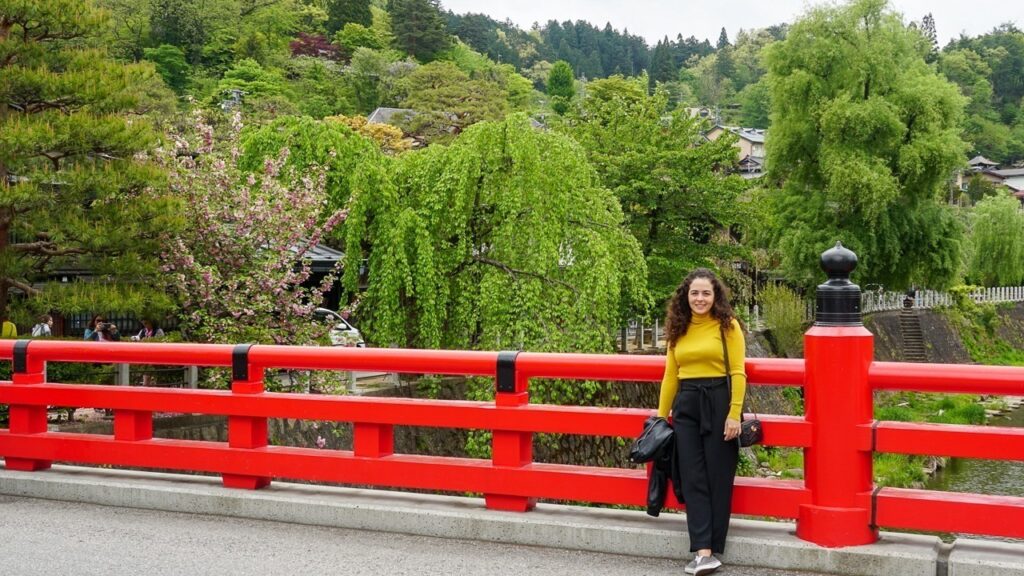
A lone cherry tree we saw in mid-May in Takayama. The region was the coldest of our trip, near the Alps.
A bit about the best months:
March: it’s still quite cold, but by the end of the month the cherry trees are starting to bloom in cities to the south of the country. Cherry blossoms occur at different times according to the height of the cities on the map and may vary from year to year. They usually bloom earlier in the south and later in the north (the season runs from late March to late April).
April: one of the busiest and most crowded months to visit Japan, because it’s indeed during April that you’ll be able to see the blossoming cherry trees. It’s also a month with major festivals, like the Takayama Matsuri (held in spring and fall). Note that you’ll still need to bring warm clothing and coats. Oh, and prepare your wallet, as this is one of the most expensive months, which also requires good planning well in advance.
*Golden Week: a giant national holiday comprised of four extended holidays that runs from late April (April 29) through early May (usually falls from May 3-6). Try to avoid being in Japan at this time, as everything gets REALLY more expensive and crowded, and the city exits get heavier with traffic and more chaotic. This is because it’s during this time that the Japanese themselves enjoy traveling.
May: our trip took place throughout the whole month of May. Earlier this month, you can still see some late and lonely cherry trees in the landscape in Honshu, but this is a bit rare (go to Hokkaido if you want to see cherry trees in early May). The days are beautiful and it usually rains very little. The temperature is already much nicer and milder (by the end of May it’s already hot), and a light coat will serve you well in most cities on the main island. According to the guides we hired, it’s the best month to visit Japan, as it’s not as crowded and expensive as April and there are different varieties of plants and flowers that only begin to bloom this month.
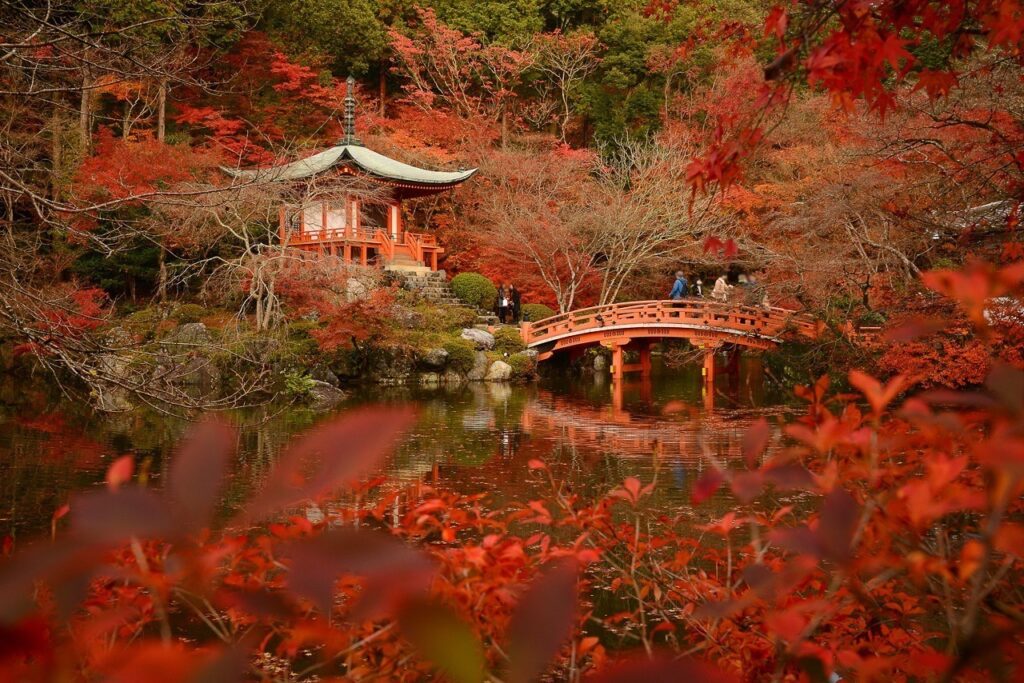
Daigoji Temple in Kyoto during the fall (but keep in mind that this is an awesome stock photo, ok? It should get red, but not toooo much so).
October: this month is still considered the high season because the rains have stopped and it isn’t too cold. But the real red autumn happens only in November.
November: is the ideal month to visit Japan if you want to see those very typical autumn landscapes with red, orange or brown foliage. After the cherry season, it’s one of the busiest times, so plan ahead.
How many days to stay in Japan? And in Tokyo and Kyoto?
The least possible amount, in my opinion, is 12 days, to compensate for the trip (travel and airfare price) and take the time to know the country well. Just think about it: you’ll have to set aside two days just to arrive in Japan, not even counting the first 4 days which are much slower and more tiring due to the time zone difference that ends up destroying us a bit. So, getting less time than this is a lot of rush and will give you more stress than joy.
Staying 15 days in the country is a great option for a general tour of the major cities, and 21 days is great for being able to include all the different nooks and crannies, such as dropping into Okinawa in the summer, a specific festival like Takayama Matsuri, or include the beautiful arts island of Naoshima or a walk through Hokkaido to see the winter landscapes.
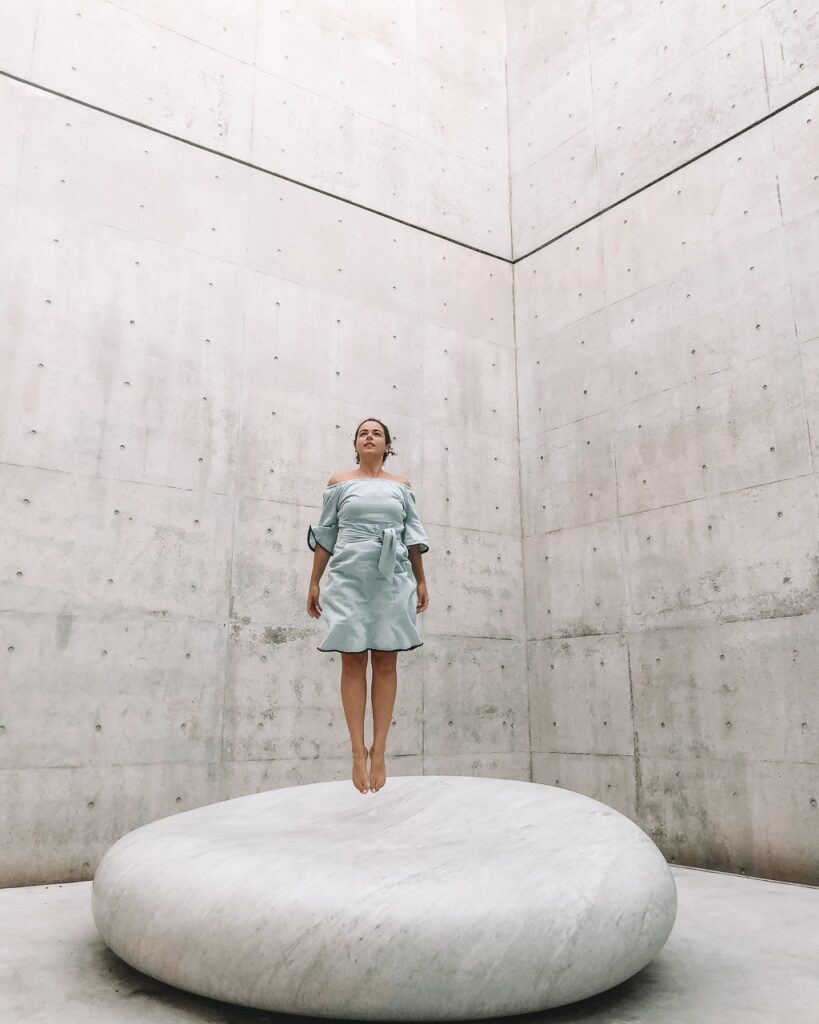
Floating at the Benesse Museum in Naoshima.
Tokyo: In Tokyo, I recommend spending 4 whole days only in the city (or 5 nights). You can get to know the main city in 3 whole days, but know that it will be busier and can take away your freedom to be spontaneous (finding a festival or having some different experiences like watching a sumo session or taking a sushi class). If you want to include Nikko or some other day trip like Mount Fuji, add one more day for each. Usually, 5-7 nights are pretty ok.
Kyoto: I stayed 5 nights in Kyoto and found it just right, and I still stayed at a ryokan on the riverside of the Katsura River on our first night there, with the purpose of this stay being to enjoy the hotel and not even leave. During this time I also visited Nara, watched a geisha show and got to know the main temples and restaurants.
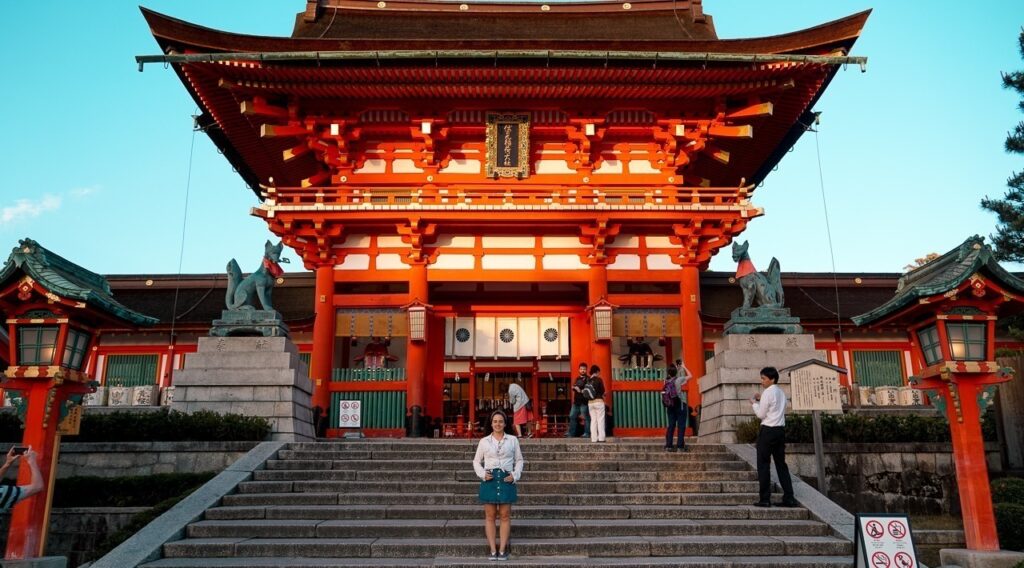
There are over 1600 temples in Kyoto alone, and 100 of them are open for visitation. There’re also 400 shrines. Temples for a lifetime.
How to get to Japan? Flights and airlines companies
There are no direct flights to Japan from the east coast or from the main countries in the americas for one precise reason: it’s VERY far away! Lol. So, inevitably, you will have to make a connection in LA, San Francisco or in another country, and prepare yourself for taking at least 24 hours to get there.
You can choose to go by almost any country in Europe, Mexico, Canada or the United States, as well as via the Middle East (Qatar and Emirates). The best, in this case, is to buy the cheapest ticket or buy the one-stop flight to somewhere where you want to stop for a few days and break the long trip in two.
Generally, the most popular low-priced tickets with the fastest flights are United, American Airlines, LATAM, Qatar, Emirates, ANA (with a connection in the West Coast).
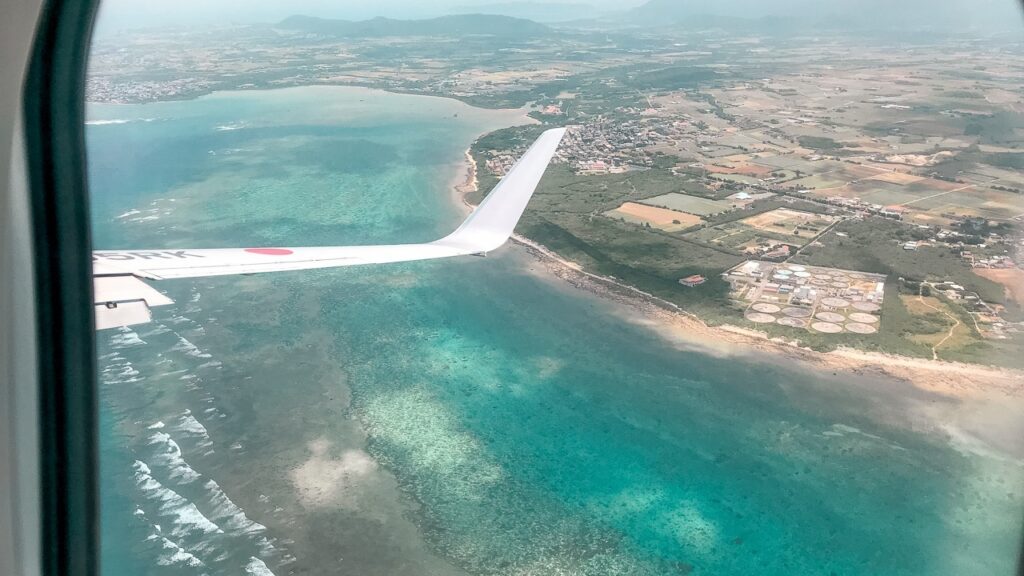
From the plane window arriving at Ishigaki, one of Japan’s Okinawa Islands and one of the few inland destinations you need to travel by plane instead of the train.
Japanese Visa: how does it work? Is it easy to get?
Many people hear the word visa and already get goosebumps (me included). There’s always a fear that this is the one detail that will prevent you from making the trip of your dreams. Japan requires visas for Brazilian citizens, and this insecurity becomes even greater when you discover that you can only apply for a visa after submitting your purchased tickets and hotel reservations.
But there’s no reason for stress or worrying! If you submit all the documents they require, there’s no reason why your tourist visa shouldn’t be approved. And getting a visa is easier than it sounds, although it takes a while to prepare the documentation.
For USA citizens, a visa is not required to visit Japan for tourism for less than 90 days. So you´re pretty much good to go!
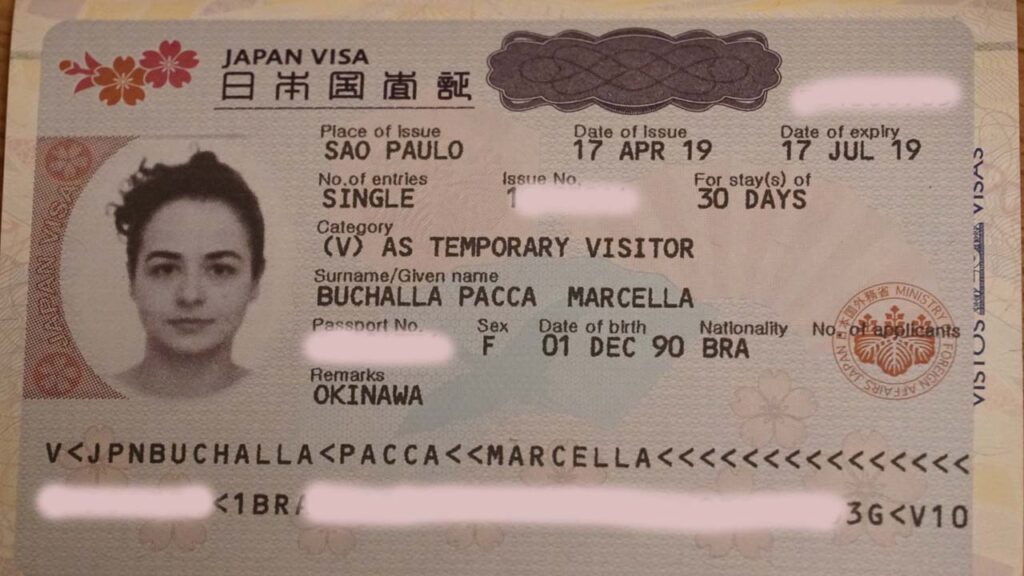
Brazilians need a visa to visit Japan.
JR Pass: the train pass that helps the tourist
The JR Pass is a tourist pass that is sold to tourists only and allows you to use most of the JR Line train lines unlimitedly for a predetermined period. This period can be 7, 14 or 21 days. This topic deserves an exclusive post, but roughly speaking, I think it’s indeed worth buying the JR Pass for its practicality, and most of the time for its price (it’s a better cost-benefit than buying single tickets).
Internet in Japan
Along with the JR Pass, you can now pay for the rent of a portable wifi device that will be the lifeline of your trip. It’s a small and easy-to-carry device, allowing you to have internet wherever you go. It can usually be used by up to 10 devices, so you can connect your smartphone and those of the people traveling with you, and also connect computers when you need them. The connection we had was always great and had a really good signal, even in remote places like Taketomi Island.
The pick up and return of the device are also very practical. You have the option to pick it up at the airport or the reception of your first hotel. We chose to pick up at the hotel because we didn’t want to have to move a single muscle when arriving in Japan after 24 hours of flight. When we went to check-in, the receptionist already gave us an envelope with a kit that contained the device, a case and the charger we used every night (by around 7 pm the battery was dead, so it’s worth having a power bank, too).
Returning it was very practical as well, as they already send you an envelope with an address filled out and all you have to do is put the items in and return them to any mailbox in town. We return it in a box at the airport just before the departure gate.
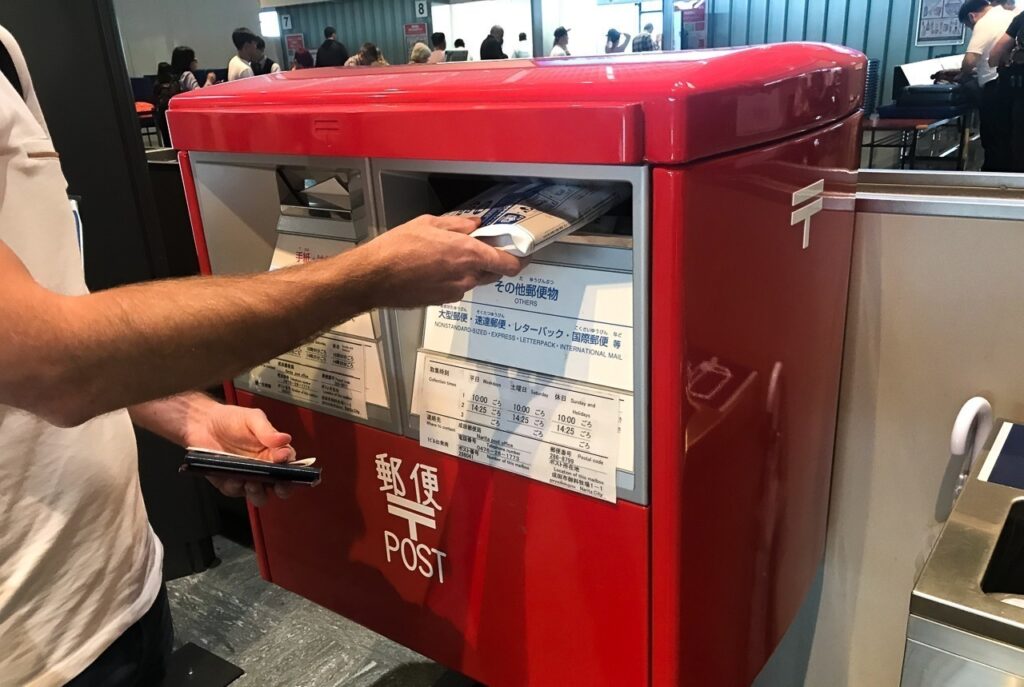
Returning the wifi device to a mailbox at the airport.
Hotel reservation in Japan
Keep this in mind if you, like us, like to hand-pick the hotels you’re staying at or if you want to stay in a busy hotel like the Benesse House in Naoshima. Book your hotels well in advance! For Benesse, especially, reserves open 6 months in advance and run out super fast.
On this trip we made our reservations directly by Booking.com to manage everything in one place, and because I had some good discounts while we were logged in with Genius. By Booking, I could see if the hotel had free canceling, which was great because we made reservations well in advance and then we still had some time to change our mind.
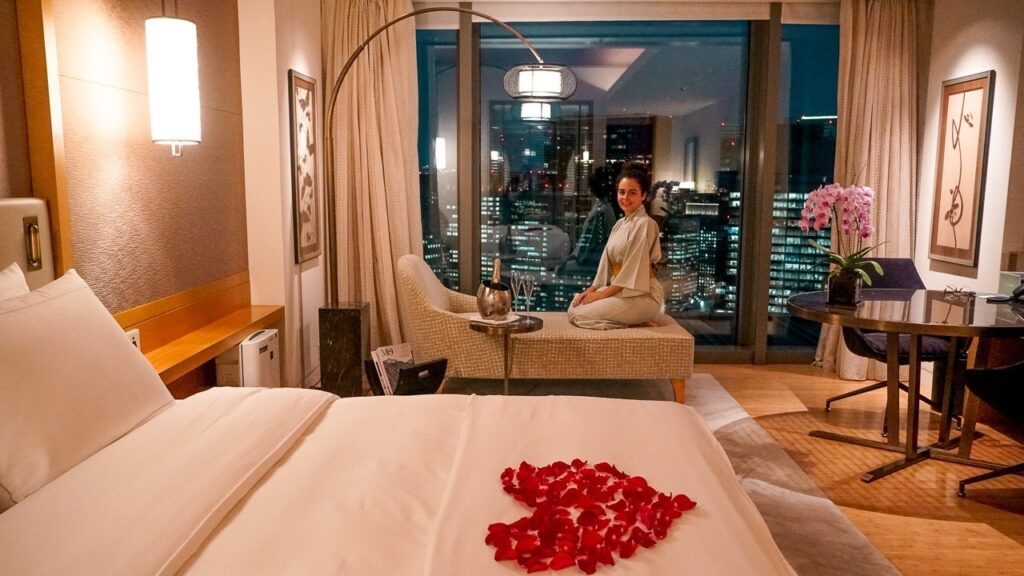
Mandarin Oriental: great location, large rooms and first-class service in Tokyo.
But if you book directly through hotel websites such as Benesse House (the only way is a direct reservation, they don’t work with booking and travel agent booking programs), you’ll notice that they don’t even ask for a credit card and ask for almost nothing, and yet the reservation is made. This is because, culturally, the Japanese honor their reservations (whether in a hotel, restaurant, etc.) and it’s extremely rude to cancel them. So, if you’re on the hotel website making a reservation, then you know you’ll go – and you will.
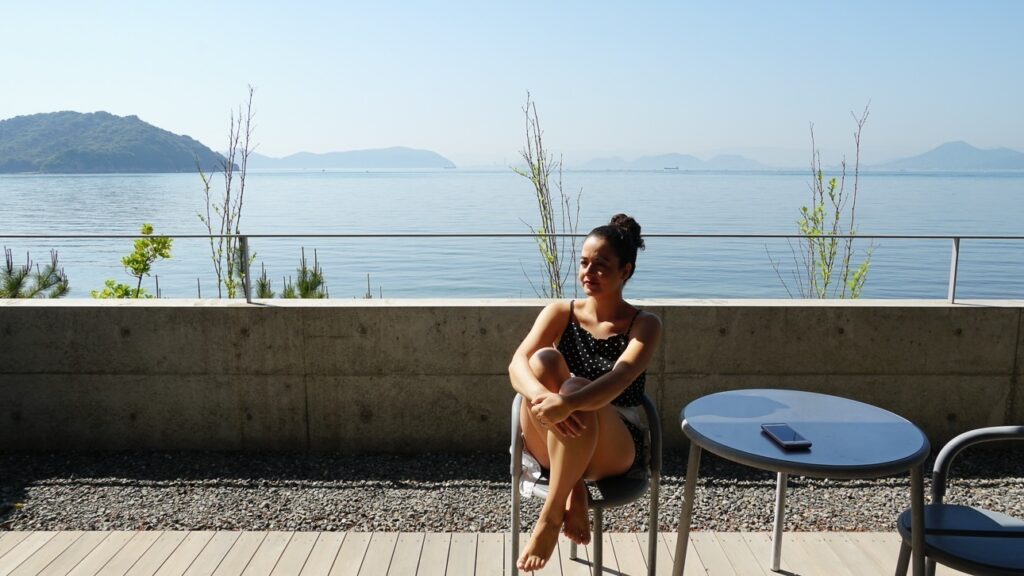
From my room’s balcony at Benesse House, in Naoshima.
What happens is that many unwarned tourists (like me) end up making the reservation to decide later if they’re really going and, if anything happens, they can cancel it. Honoring reservations is not something we do a lot when talking about hotels or restaurants. Then, there’s a possibility to book directly through hotel websites and cancel later (up to 8 days before, usually), but keep in mind that this is very rude to them. Also, sometimes a hotel will appear to be full on the website, but if you keep an eye out every day there may be a few cancellations and you can catch a break (easier when it’s for one night only).
Money in Japan, and buying Japanese yen in Brazil
We researched and concluded that it would be easier to buy yen here from Brazil. It’d be a lot of work for us to land tired from our flight and still have to look for a currency exchange with good quotes. We wanted to be up and running from the beginning.
We bought an amount that would cover most of our expenses and were able to negotiate the value of the exchange well. But it’s important to say that we need to call and reserve these yen in advance, as no exchange offices had high values available. Few of them had yen, and those that had were in low volumes, amounting to U$800 or so.
Oh, and it is worth mentioning that we enabled our credit card for international purchases and we also could make credit card withdrawals at ATMs from places like 7-Eleven. And that indeed happened, because we spent more than planned.
Read also: How much does it cost to travel to Japan? Example of real expenses.
Security in Japan
Japan is a VERY safe country. The crime rate is extremely low and the murder rate is one of the lowest in the world. Looking back, I think it was the country that I felt most respected as a woman and a foreigner. I would easily suggest Japan as a travel option for women traveling alone, and if asked about security I’d say exactly what I said in the first sentence of this paragraph.
Language in Japan: is possible to get around only with English?
A lot of people freaked me out about this subject, saying that communication in Japan would be difficult without being able to speak a word in Japanese. But what I saw was the complete opposite of that. Menus in English, information signs also in English most of the time, and people extremely concerned and willing to help, whether or not they speak another language.
In Tokyo and Kyoto, most people spoke English, though often with a thick accent. I’ve been to places less popular among tourists like the remote island of Taketomi, and I’ve always managed to get around one way or another. If that’s your concern, you don’t have to worry. You’ll surely be able to get around nicely with only English.
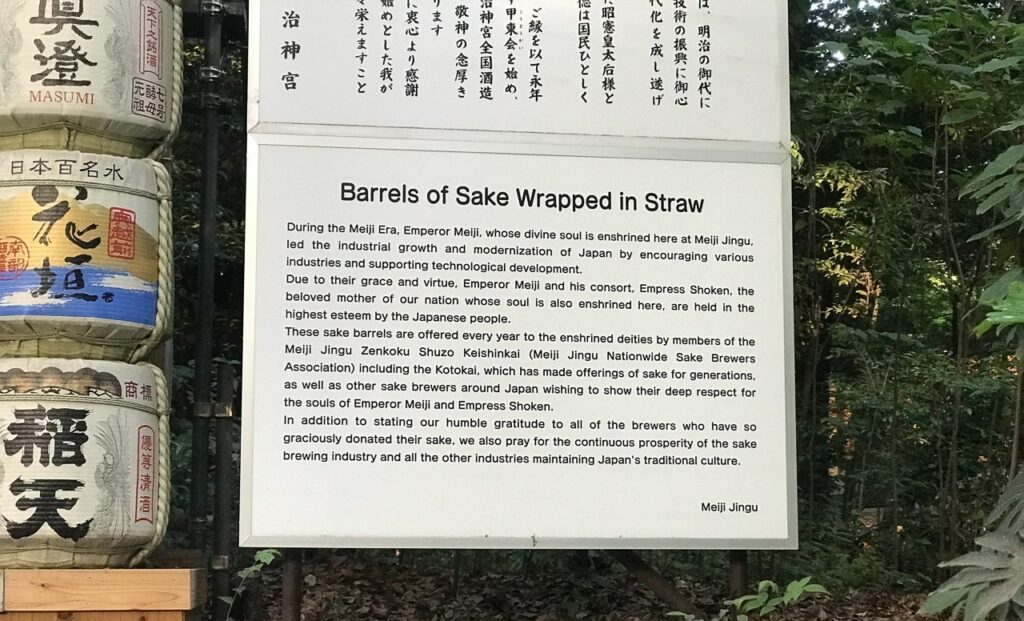
Japanese and English sign at Yoyogi Park, where the Meiji Shrine is located, in Tokyo.
Takkyubin: luggage mailing service to other cities (extremely handy!)
Throughout the country, there’s a wonderful luggage delivery service, which means that they send your bags from one hotel in one city to another. The reception of most hotels has this service and the cost is around 3,000 yen (USD 28) for two medium bags. It sounds expensive, but you have no idea how this service comes in handy!
You can arrive in Tokyo, for example, and send your bags to Kyoto, and in the meantime travel the countryside for a few days. Or leave Kyoto, visit Naoshima and Hiroshima, and only get your bags at the Tokyo hotel.
Bags usually arrive the day after shipping. For the islands of Okinawa, shipping may take up to 3 days.
We loved it, found it super practical and highly recommend it! Look for a sign with the yellow kitten at your hotel and you´ll know they have this service.
I don’t eat sushi or raw fish. Am I going to starve in Japan?
Absolutely not! All the people who don’t eat raw fish asked me this question and were surprised when I said I ate some of the best beef of my life in Japan. They were simply wonderful e melt at your mouth (although they were a bit more expensive, like Hida Beef or Wagyu and Kobe).
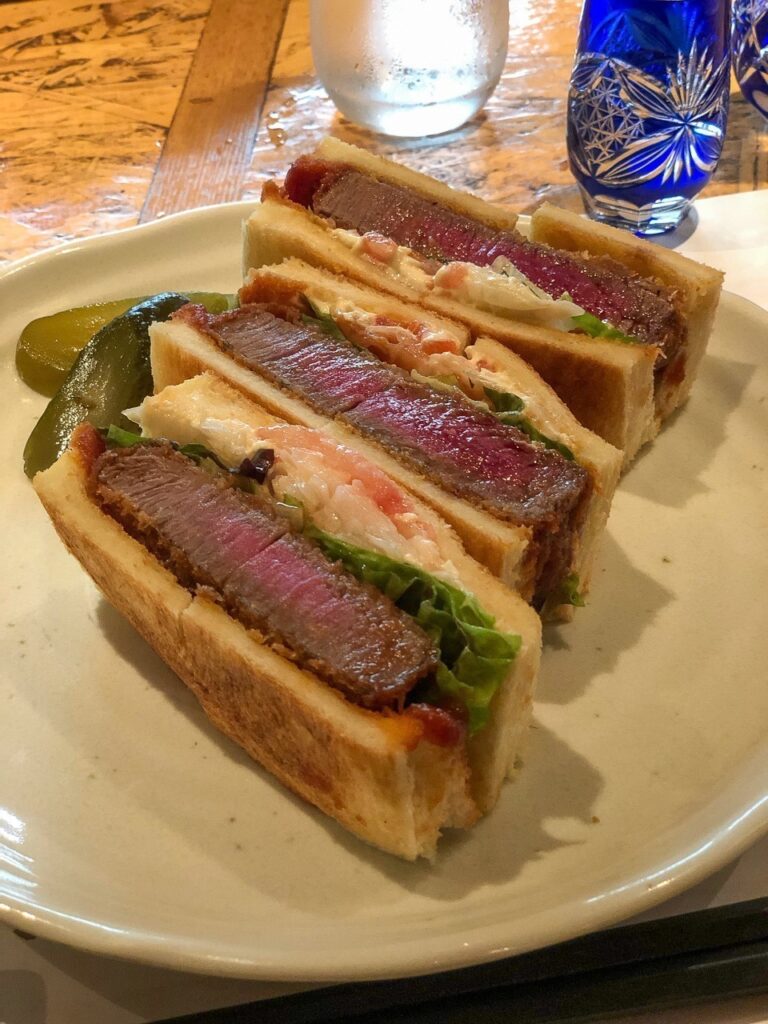
Hafuu’s famous Wagyu sandwich, in Kyoto.
Besides, Japanese cuisine is not just about sushi and raw fish. There are many delicious hot dishes like donburi (a rice bowl with some meat or fish on top), tonkatsu (fried and breaded meat, usually pork), gyozas, tempura, yakitori (chicken kabobs), pasta, like udon, soba or even the world-famous yakisoba, as well as many other options. Oh, and not to mention the western dishes. There you’ll also find pizzas and hamburgers, French, Italian, and Chinese cuisine, and food from many other countries.
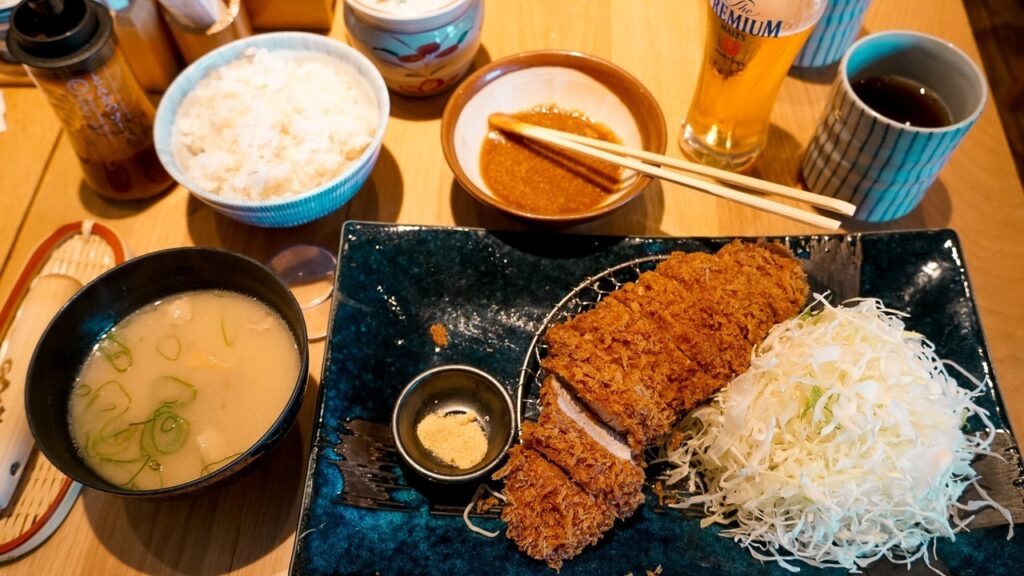
A simply divine Tonkatsu in Kyoto. Nothing more than a breaded pork fillet with rice and gravy. Sounds easy, huh?
For breakfast, most hotels offer a choice of traditional Japanese breakfast and western breakfast. So you can take a risk if you’re feeling adventurous or choose a breakfast of eggs, bread, and cold cuts, like the ones you’re already used to.
I garantee you, you won’t starve.
Still have some questions?
We’re slowly publishing several posts about Japan, but for now, we have:
–How much does it cost to travel to Japan? Example of real expenses
–5 most impressive temples I visited in Japan
–10 weird things you’ll only see in Japan
But if you have any other questions about Japan, you can leave a comment below that we always get back to you! Oh, and preferably comment in the WordPress box, not on Facebook’s, because through WP we get a notification and we can reply faster. =)






Deixe seu comentário